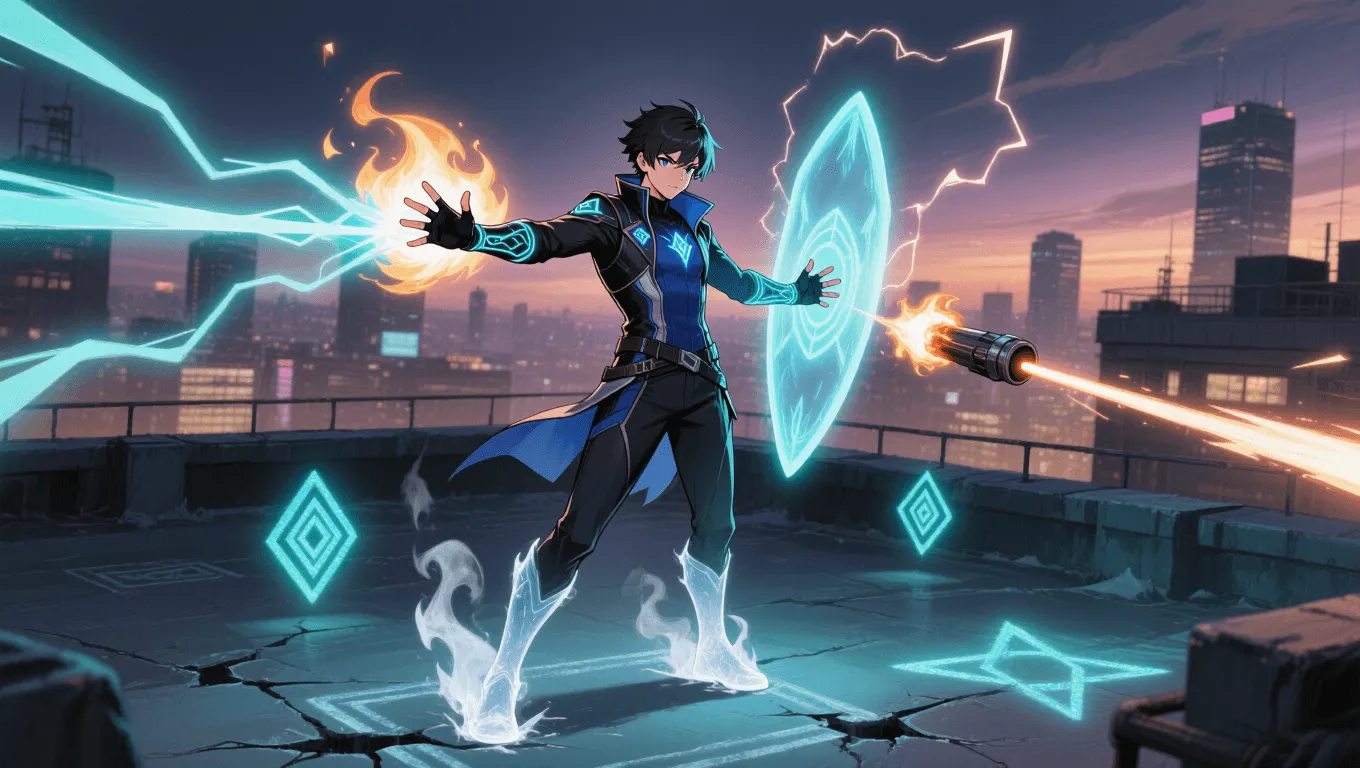Runic Resonance: Power Guide, Uses, and Counters

Runic Resonance Video Demo 🎬
Table of Contents
- Runic Resonance Video Demo 🎬
- What Is Runic Resonance
- Core Abilities of Runic Resonance
- Application / Tactical Advantages in Combat
- Level: Level 1 🏙️, Level 2 🌇, Level 3 🌃
- Limitations of Using the Runic Resonance
- Weakness Against What Other Superpowers
- Synergistic Power Combos
- Known Users
- Practical Keywords and Concepts (for learners)
- Field Notes for Training and Safety
What Is Runic Resonance
Runic Resonance is a superpower that lets a user inscribe, project, and activate arcane runes whose meanings are converted into energy patterns that “ring” at specific frequencies. These frequencies interact with matter, mind, and magic, producing effects like barriers, enhancements, and elemental bursts. Unlike generic spellcasting, Runic Resonance relies on glyphs, sigils, and structured patterns—what practitioners call runic arrays—whose shapes and spacing determine the outcome. Mastery involves understanding how symbolic geometry, timing, and intent harmonize so the runes resonate rather than misfire. In short, Runic Resonance is rune magic tuned like music: if the glyphs are notes, resonance is the melody that makes them work.
For readers exploring more powers, browse the full catalog in the Superpower Wiki or roll something unexpected with the Random Superpower Generator.
Core Abilities of Runic Resonance
1) Glyph Casting and Projection
Users form runes in the air with light, carve them into surfaces, or stamp them onto equipment. Projected glyphs persist for a short time and can be “strummed” by gesture, voice, or thought to trigger effects. This is the backbone of resonant sigils and battlefield utility.
2) Resonant Shields and Wards
Circular arrays produce harmonic interference that deflects force, heat, kinetic objects, and some energy attacks. Properly tuned wards can filter specific frequencies—e.g., blocking sonic shockwaves while letting air pass through. Defensive arrays also dampen shock and reduce concussive damage.
3) Elemental Modulation
Runic channels redirect ambient mana into elemental outputs: flame sigils that burn clean and blue, frost glyphs that leech heat, and storm runes that ionize air for controlled lightning arcs. Because output maps to pattern density, a tight lattice yields precise beams while a loose weave creates area effects.
4) Enhancement and Enchantment
Attunement runes overlay the user’s body or gear to boost speed, awareness, or durability. Edge-glyphs on blades increase cutting efficiency, while binding runes keep armor articulated but rigid on impact. Long-form engravings act as semi-permanent enchantments.
5) Frequency Attunement and Debuffs
By matching the “note” of a target—metal, stone, even a nervous system—a practitioner can create sympathetic vibrations. Results range from tool-softening micro-shivers to equilibrium-scrambling hums that disorient foes. Ethical users avoid prolonged neural resonance due to collateral risks.
6) Sigil Traps and Tactical Fields
Delayed-activation sigils trigger on motion, pressure, or sound, enabling ambushes, tripfields, and retreat covers. Rune mines can emit a resonance cascade that pushes enemies apart or collapses footing under precise frequency stress.
7) Transliteration and Counter-Glyphs
Experienced users read hostile sigils and sketch counter-runes that detune, invert, or overground the effect. This makes Runic Resonance a potent anti-mage discipline when facing wards, seals, or enchantments based on symbolics.
Application / Tactical Advantages in Combat
-
Zone Control: Quick-drawn ward rings reshape battle flow, sealing hallways, narrowing choke points, and isolating high-value targets without permanent damage.
-
Tempo Manipulation: Enhancement runes surge sprint speed or reaction acuity for brief windows, letting users win initiations and disengages.
-
Low-Profile Firepower: Elemental glyphs strike with little muzzle flash or recoil, good for stealth. The sound is a muted chime, not a thunderclap.
-
Countermeasure Superiority: Reading and canceling enemy sigils turns opposing casters into spent forces. Disenchantment glyphs also strip boons from buffed foes.
-
Resource Efficiency: Runes act as “stored instructions.” One calm setup before an engagement can produce multiple triggers mid-fight, conserving mental load and energy.
-
Non-Lethal Options: Frequency debuffs, gravity-softening pads, and kinetic diffusers allow capture or evacuation operations with minimal harm.
Level: Level 1 🏙️, Level 2 🌇, Level 3 🌃
Level 1 🏙️ — Initiate of the Lines

-
Capabilities: Basic glyph casting, short-lived wards, small elemental bursts (palm-sized flame, frost patches, static snaps). Simple self-buffs (focus, light armor hardening).
-
Limits: Runes degrade quickly; mis-drawn lines fizzle. Two to three active runes max before accuracy drops. Requires visual line-of-sight to place.
-
Tactics: Use pop-up shields to block projectiles, lay simple trip sigils, and enhance reactions when breaching. Avoid prolonged duels with heavy hitters.
-
Training Focus: Line discipline, geometric memory, and safe deactivation drills. Learn to end a miscast without backlash.
Level 2 🌇 — Composer of Arrays

-
Capabilities: Multi-layer wards with selective permeability, mid-scale elemental weaves (cone lightning, heat lenses), chained sigils with timed triggers, and refined sympathetic debuffs (motion blur, vertigo pulses).
-
Limits: Complex arrays drain stamina; sustained fields risk harmonic drift. Environmental noise (sirens, turbines) can detune delicate patterns.
-
Tactics: Set battlefield “scores”—overlapping trapfields, cover-rings, and fallback bridges. Counterspell hostile circles with transliteration glyphs on the fly.
-
Training Focus: Frequency ear—identifying materials’ resonance quickly. Practice drawing under stress, with moving surfaces and bad lighting.
Level 3 🌃 — Maestro of the Veil

-
Capabilities: City-block ward domes in emergencies, precision resonance that disarms weapon systems, wide-area dampening that ends riots without lethal force, and modular enchantments that last for days. Can overground enemy mega-arrays safely.
-
Limits: High risk of resonance cascade if misaligned with multiple power sources. Large-scale arrays need anchors and spotters. Ethical constraints around neural frequencies remain strict.
-
Tactics: Orchestrate full-theater control: quietly isolate threats, stabilize infrastructure, and neutralize exotic powers by detuning their conduits.
-
Training Focus: Team command, anchor logistics, and legal/medical studies for non-lethal resonance applications.
Limitations of Using the Runic Resonance
-
Line Integrity: A single smudge, gap, or angle error can collapse output or redirect force. Rain, dust, and vibration degrade stroke fidelity.
-
Cognitive Load: Each active rune occupies mental “bandwidth.” Overstacking arrays causes lag, headaches, and motor errors.
-
Material Sensitivity: Some mediums (oily metal, brittle glass) resist rune adhesion, while others (untreated wood, bone) over-absorb, blurring intent.
-
Environmental Detuning: Loud, overlapping frequencies—industrial engines, concert subwoofers—can scramble harmonic timing, weakening effects.
-
Energy Budget: While efficient, large constructs still draw heavily on ambient mana or the user’s reserves. Overuse leads to tremors and blackouts.
-
Legal/Ethical Boundaries: Neural interference, forced confessions via “truth-chord,” or structural resonances on occupied buildings violate most codes of conduct.
Weakness Against What Other Superpowers
-
Chaos Manipulation / Entropy Fields: Randomization powers disrupt geometric order, making precise arrays unravel.
-
Anti-Magic / Null Zones: These deaden the mana substrate, muting resonance entirely or forcing brute physical solutions.
-
High-Velocity Kinetics: Speedsters and railgun-class projectiles can cross a ward’s boundary before full activation unless pre-primed.
-
Sonic Overload / Vibration Control: Targeted counter-frequencies detune or shatter glyphs mid-cast, especially those relying on fine phase timing.
-
Shadow/Ink Corruption: Powers that warp or smear physical mediums can deface inscribed lines without touching the caster.
-
Reality Editing: Literal rule-benders invalidate the symbol-to-effect mapping, causing safe fizzles at best and recoil at worst.
Synergistic Power Combos
-
Chrono-Stability + Runic Resonance: Micro-time dilation around arrays gives “perfect draw time,” protecting line integrity during combat.
-
Telekinesis + Resonant Sigils: Invisible hands place runes on moving objects—drones, vehicles, thrown blades—for remote detonations or mid-air shields.
-
Geo/Metal Shaping + Glyphwork: Sculpt smooth, rune-friendly surfaces and embed anchors into terrain for lasting fortifications.
-
Light Manipulation + Sigil Veiling: Bend illumination so arrays are invisible until they flare, foiling counter-casters.
-
Soundcraft + Harmonic Glyphs: Friendly sonics reinforce correct frequencies, boosting shield efficiency and extending range.
-
Healing Factor + Overcast: Resilient users can tolerate the fatigue spikes of large domes or emergency resonance dumps.
-
Data Vision (Technopathy) + Transliteration: On-the-fly recognition of enemy sigil sets enables instant counter-glyph recommendations.
Known Users
-
Archivist of Halcyon — A scholar-hero who perfected selective-permeability wards for evacuation corridors.
-
The Street Engraver — An urban vigilante using chalk-and-brick arrays to control gang conflicts without lethal force.
-
Eira Vale — A first responder who combines frost runes with cushioning sigils to stop fires and rescue victims from collapses.
-
Doctor Strange — Known for symbol-based spellcraft and protective circles; while not strictly the same system, his use of glyphic structures shows strong parallels to resonance-based defense and portals. Learn more about Doctor Strange.
-
The Luthier — An acoustic prodigy who “plays” runes with a modified violin, amplifying field stability through tuned harmonics.
For more powers that pair well with this discipline, continue exploring the Superpower Wiki, or shake things up with a fresh idea from the Random Superpower Generator.
Practical Keywords and Concepts (for learners)
Runic Resonance, rune magic, glyph manipulation, sigil casting, resonant sigils, harmonic glyphs, arcane runes, wards and barriers, enchantment arrays, frequency attunement, sympathetic magic, ritual circles, runic arrays, detuning, transliteration glyphs, resonance cascade, elemental modulation, kinetic dampeners, mana channeling, anti-magic countermeasures.
Field Notes for Training and Safety
Preparation
-
Carry multiple media: wax pencils for metal, chalk for stone, paint pens for wet conditions, micro-projectors for skywriting glyphs.
-
Practice “blind draw” drills to inscribe correctly without staring—vital under fire.
-
Keep a three-layer fallback: emergency shield ring, neutralizing counter-glyph, and a quickstep enhancement.
Ethics
-
Avoid neural-frequency work except under strict oversight and with medical support.
-
Use structural resonance on buildings only after confirmed evacuation and with engineering sign-off.
-
Log all large-scale arrays and anchor placements for later deactivation.
Maintenance
-
Inspect inscribed gear daily; micro-cracks change resonance.
-
Rotate enhancement runes to prevent harmonic fatigue in joints and ligaments.
-
Archive successful array diagrams for reuse; name them like songs for quick recall.
By treating symbols as instruments and the world as a resonant chamber, practitioners of Runic Resonance transform careful geometry into decisive, humane power—protecting lives, shaping battlefields, and neutralizing threats with precision rather than excess.
